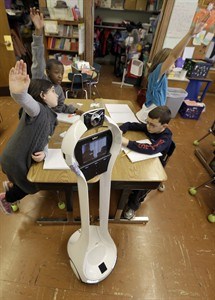
In this Thursday, Jan. 24, 2013 photo, Devon Carrow attends Winchester Elementary School from home while operating a robot in the classroom, in West Seneca N.Y. Carrow's life-threatening allergies don't allow him to go to school. But the 4-foot-tall robot with a wireless video hookup gives him the school experience remotely, allowing him to participate in class, stroll through the hallways, hang out at recess and even take to the auditorium stage when there's a show. (AP Photo/David Duprey)
February 15, 2013 - 6:04 AM
WEST SENECA, N.Y. - In a school hallway, a U.S. teacher takes her students to the library, leading a single-file line of giggling boys and girls that's perfectly ordinary until you get to a sleek white robot with a video screen showing the face of a smiling, chubby-cheeked boy.
Devon Carrow's life-threatening allergies don't allow him to go to school. But the robot with a wireless video hookup gives him the school experience remotely, allowing him to participate in class, stroll through the hallways, hang out at recess and even take to the auditorium stage when there's a show.
What's most remarkable is how unremarkable this technology is viewed by his classmates. In a class of 7-year-olds raised on video games, avatars and remote-controlled toys, they don't see a robot. They just see Devon.
Just before class one recent day, a girl leaned toward the robot to tell Devon the joke making the rounds at school: Why did the boy eat his homework? The teacher told him it was a piece of cake.
While making get-well cards for him during a hospital stay last year, his classmates all drew him as a boy, not a bot.
"In the classroom, the kids are like, 'Devon, come over, we're doing Legos. Show us your Legos,'" says teacher Dawn Voelker.
"I wondered how the little kids would take to him, thinking they'd be amazed," adds Principal Kathleen Brachmann. "But I think kids are so tech-savvy now that they accept it more than we do."
Even Devon doesn't quite get what all the fuss is about. Steering the four-wheeled robot through school and spinning around to see the classmates is just another mouse-and-keyboard challenge.
"It's so cool because it's like playing a game on the computer," says the boy. "It's like your objective is to just survive."
For a year now, Devon has attended school using "VGo," a robot shaped a little like a chess pawn.
Since it was introduced in 2011 by VGo Communications, a handful of students across the country have used it.
It's also attracting attention in the medical and business worlds, allowing doctors to consult with patients and workers to virtually pop into the office, even while travelling.
For Devon, it was a chance to go to school for the first time in his life. He has eosinophilic esophagitis, caused by an allergic white blood cell that grows in his stomach and esophagus. He's also got anaphylactic shock syndrome, which causes life-threatening allergic reactions to triggers including milk and peanuts.
Even though attacks have put him in the intensive care unit twice in the past 18 months, Devon is outgoing and energetic, whose personality better suits him to the school experience rather than home-schooling.
But after teachers at Devon's previous school in New York state resisted the idea of having the VGo's camera in the classroom, his mother persisted, and Devon was welcomed at another school.
It was added to Devon's special education plan, and the cost — about $6,000 for the robot and $100 in monthly service fees — is being paid out of the district's budget.
The technology broadens Devon's school experience beyond what would be possible through a video chat. The only restrictions are physical.
The robot senses stairs and stops, but even they aren't insurmountable because, at 18 pounds (8 kilograms), the robot is light enough for a teacher to lift.
On a recent weekday, Devon positioned himself in front of his home computer's camera and dialed in to Mrs. Voelker's room for the 9:10 a.m. start of school. He controls the VGo alongside teacher Sheri Voss, who comes to his house daily to help navigate and keep him on task.
"We don't treat him any differently," Voelker said. "He still has to turn in his homework. He still has to have his mother sign notebooks. He still has a job in this classroom — he's the greeter.
"And he still has to pay attention — although there's times I look and he's off, the cat's coming in the room."
He's heard through the VGo's speakers. Voelker wears a microphone that amplifies the teacher's voice, which helps all of the students, including Devon, hear her. Instead of raising his hand in class, Devon activates a light on the VGo.
"It's really fun having him in the class," said Caitlyn Bedient, who sits a few desks away. "He has toys at home, and we can show him the creations we make."
Classmate Daisy Cook said it was a bit awkward at first, and it didn't quite seem fair that Devon got to stay home and go to school.
"But now it's kind of cool," she said, her eyes widening, "because we can communicate together. It's like he was never on the VGo."
___
Associated Press videojournalist Ted Shaffrey contributed to this report,
News from © The Associated Press, 2013